Nostalgia: Falkirk was streets ahead with road for new buses


Regular readers of this column will know that I am a great admirer of the Victorian and Edwardian buildings which give our town a touch of class that later architectural efforts have done much to destroy.
But there are exceptions to this rule and the best example in Falkirk is Princes Street which dates back only to the 1930s.
Advertisement
Hide AdAdvertisement
Hide AdNew developments usually mean the loss of something old and valuable but not always!


Back in the 1930s the expansion of public transport led to the opening of the new bus station in the Callendar Riggs and taking a big bus from the west end meant a difficult squeeze up Vicar Street and along Bank Street.
To solve the problem the powers that be decided to give us a completely new street and, in 1933, the Prince of Wales later King Edward VIII was in town to open Princes Street.
At its east end, the new street was driven through the playground of the old Grammar School in Park Street and at the west end it replaced the old Argyll Bar which was rebuilt on the corner.
Advertisement
Hide AdAdvertisement
Hide AdOn the opposite corner the developers gave us the Tudor House, a mock-up of an old English half-timbered building which seems so out of place in the middle of a Scottish town and yet is now so familiar and attractive that we would be really annoyed if it was lost or damaged.
But the great glory of Princes Street is not the Tudor House or even the Grammar School of 1843, the forerunner of Falkirk High.
The 1930s was the great Art Deco period of design and a new street offered Falkirk the chance to show that it was up to the minute in its taste.
Most of the buildings are (or were) good examples of the style including the Argyll Bar, now The Wine Library, and the former Young’s store which was Rosie O’Grady’s.
Advertisement
Hide AdAdvertisement
Hide AdHowever pride of place must go to the great sweep of the picture house modelled, as many Art Deco buildings were, on the great ocean liners like the Queen Mary right down to the detail of the handrail along the top.
The building which is now the City Bar had started life as The Grand Theatre in the Edwardian era with its entrance on Vicar Street.
It served Falkirk very well over the years offering ‘‘a slightly higher class of entertainment’’ than the music hall in the Roxy!
With the opening of the new street the chance was taken to transform the Grand into a super deluxe cinema which most older bairns will remember as the Regal or the ABC or the Cannon.
Advertisement
Hide AdAdvertisement
Hide AdBy this time the town had four other picture ‘‘palaces’’, the Cinema in Melville Street, the Salon in Vicar Street, the Picture House in Bank Street and the Pavilion in Newmarket Street.
Falkirk, like most towns, went film mad especially after the talkies arrived in the late 1920s and so the new place was a great success.
I remember the queues along the street in the 1950s being entertained by the one and only King Kenny complete with a banjo with most of the strings missing.
Poor old Kenny is long gone and all the picture houses have been replaced by the multiplex in the retail park.
Advertisement
Hide AdAdvertisement
Hide AdAm I looking back with rose-coloured glasses or was the town really much more interesting in those post war days?
It certainly seemed full of life with all the butchers, barbers, bakers, grocers, fishmongers, shoemakers, tailors, pubs and sweetie shops with hardly a car or car park in sight.
Comment Guidelines
National World encourages reader discussion on our stories. User feedback, insights and back-and-forth exchanges add a rich layer of context to reporting. Please review our Community Guidelines before commenting.